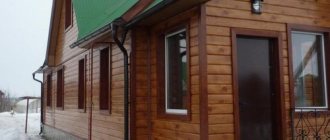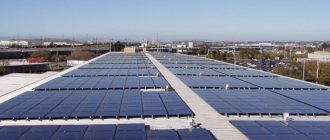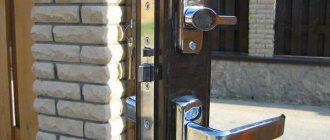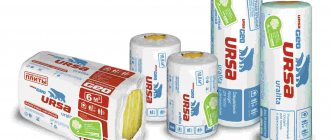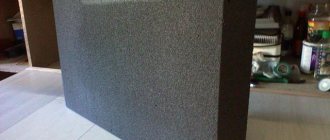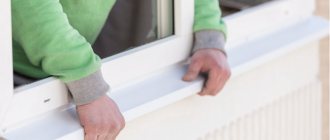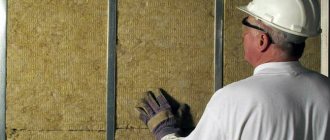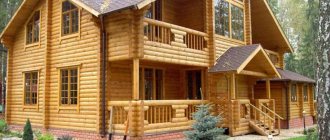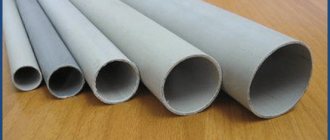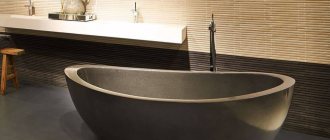Technical cork for insulating and soundproofing the premises of a house or apartment belongs to the category of the most effective natural materials, absolutely harmless to humans and the environment. This insulation is otherwise called cork agglomerate, and it is produced in two versions - in sheets or slabs of various thicknesses and in sheets rolled into rolls.
Technical plug for insulation
Due to its many positive characteristics, cork flooring is quite popular, despite its rather high cost. This publication is devoted to the advantages and disadvantages of such material.
Cork production and its structure
Cork insulation is based on the bark of the cork oak (Quércus súber), which is distributed only in a few countries: Tunisia, Morocco, Algeria, Italy, Spain, France and Portugal. Half of the total volume of this raw material is generated by plantations in Portugal, where this industry is of national importance. All countries producing natural cork export about 170 thousand tons of this rather rare material per year, which, in conditions of high demand, keeps its prices at a consistently high level.
Cork oak bark was used as insulation back in the Middle Ages by Spanish monks, who used it to decorate the floors of their cells. Mass industrial production of pressed cork chips (agglomerate) dates back to 1891, when this method was officially patented in the USA. The largest supplier of this material is the Amorim Group, all of whose branches are located in Portugal. The company began its path to success back in 1870; at the moment, more than 40 large industrial productions are united under this brand.
The microstructure of cork bark is a series of hard capsules connected in series, having the shape of an irregular polyhedron. The closest analogue of such a structure would be a honeycomb. Each capsule has a complex structure consisting of several layers:
- On the outside, it is covered with two layers of fiber, giving it structure.
- This is followed by a hollow chamber filled with a gas mixture close to atmospheric air (the only difference is the significantly reduced carbon dioxide content).
- Next is a drop of tree resin - suberin, which makes up the majority of all cork material.
- The core of the capsule also consists of celluloses, which gives it internal rigidity.
There are about 40 million of these capsules per 1 cm3 of cork raw material, which creates a unique membrane structure that has virtually no disadvantages. Internal cavities significantly reduce the thermal conductivity of this material, which makes it a high-quality insulation. At the same time, the high concentration of resin almost completely prevents the absorption of moisture, which is the main factor influencing the destruction of most thermal insulators.
In percentage terms, the composition of the cork looks like this:
- Suberin - 60%.
- Cellulose - 20%.
- Lignin, which binds rigid cellulose structures - 12%.
- Water - 5%
- Other impurities (tannins, cyrin, etc.) - 3%.
Raw cork raw materials have the following technical characteristics:
- Thermal conductivity - 0.04 ± 0.1 W/m*K.
- Water absorption percentage ≤13% of total mass.
- Density - 245 ± 5 kg/m3.
- The maximum withstand pressure is 1 t/cm2.
- Hardening at low temperatures, which quickly disappears when exposed to heat.
Moreover, all types of cork insulation have high levels of sound insulation and fire safety. Excellent sound absorption allows this material to be used as a separate means for creating special acoustic conditions. Also, the cork does not support combustion even when exposed to an open flame.
Varieties of heat-insulating materials based on natural cork
Natural cork raw materials can act as a heat insulator. But at an extremely high cost, it is more advisable to use special materials based on it, which include expansite (black agglomerate) and impregnated plates (white agglomerate). Cork bark is best used as a decorative finish for floors and walls. Its thin layer will not provide complete thermal insulation, but its original appearance can decorate any interior.
Both of these materials are produced on the basis of cork raw materials crushed into granules. The technology for producing black agglomerate involves heating to 300°C, which triggers the process of sublimation of suberin and, as a result, produces a homogeneous mass. By increasing the volume of internal cavities, the initial volume can increase up to 30%, which has a positive effect on the thermal conductivity and cost of the material.
The international format for this material is 1000 by 500 mm slabs. But depending on the brand, its thickness can vary from 10 to 300 mm. Thin sheets up to 50 mm are rolled into rolls, while thicker ones are supplied in the form of ready-to-use slabs. Due to swelling, the density of the expansite decreases to 120 ± 10 kg/m3, but the thermal conductivity remains at the same level - 0.04 W/m*K. This type of thermal insulation can be used at temperatures ranging from −200 to +150 °C, which allows it to be used even for insulating unheated floors and walls.
The technology for producing white agglomerate is much simpler: cork granules are pressed with the addition of natural adhesives. The standard format is slabs 900 by 600 and 1000 by 500 mm. If the sheet thickness does not exceed 50 mm, impregnated plates are also rolled into rolls. Density ranges from 110 to 260 kg/m3, average thermal conductivity is 0.05 W/m*K.
What is a roll cork
Cork is recycled oak bark. Cork oak grows in the Mediterranean region. Cutting the bark from a tree does not destroy it, because oak is capable of regenerating itself. Several harvests are taken from one tree.
The oak produces its first harvest at 20-25 years old; the top layer of bark is taken from it. A new layer appears after 6-9 years. Only starting from the second harvest, high-quality material is obtained from the bark.
There are two technologies for making cork floors:
- Solid thick pieces of veneer are selected and sorted by color and structure. Expensive cork parquet is made from this material.
- An economical and technologically advanced option is agglomerate. The removed bark is crushed and pressed at high temperatures. To ensure that the crushed particles adhere to each other, an adhesive composition – lignin – is used. For greater strength of the material, polymer glue can be used.
The agglomerate technology is used to produce technical plugs, which we will discuss in more detail.
Specifications
The characteristics of insulation depend not only on the properties of the material, but also on the form of its manufacture. Therefore, if we talk about this material as a whole, we can outline its average characteristics:
- the density of the material is 110-130 kg/cm3;
- specific gravity 200 kg/m3;
- thermal conductivity 0.04 ± 0.1 W/m*K;
- vapor permeability 0.2 mg/m*hour*Pa
- fire resistance class M3.
It is important to know that manufacturers of cork insulation claim that it is not subject to aging . Therefore, it will serve as long as the building itself lasts.
Varieties
The cork is produced in the form:
- agglomerate – white and black;
- roll material;
- dense slabs.
White agglomerate
This type of insulation is used for interior work and does not require finishing; it is obtained from the bark of tree branches. Under the influence of high temperature, the crushed material is pressed using glue. The plates have:
- fire resistance class M3;
- high density up to 130 kg/m3;
- minimum percentage of humidity;
- and high sound absorption coefficient.
Due to its light weight and thickness, white agglomerate is suitable for internal insulation, interior decoration and as a soundproofing material.
Black agglomerate
Black cork insulation is used for interior work; it is produced in the form of slabs. It consists of compressed granules. They are heated and partially charred, which gives the material a dark color.
Black agglomerate is intended for insulation of roofs, walls, suspended ceilings, floors, and also as a soundproofing material. The panels do not absorb moisture, they are resistant to the formation of harmful bacteria and mold. Material properties:
- density from 95 to 130 kg/m3;
- thermal conductivity -0.040 W/μ;
- low vapor permeability;
Roll version
It comes in different grain sizes and thicknesses. On average, the length of the roll is 25 square meters. m., it is used as a substrate for parquet, laminate and as insulation for walls.
Rolled cork is not used for heated floors. The material has high thermal insulation properties and therefore the heat from the source will warm the ceiling, and not the floor and air in the room.
Tile
This is a thicker type of material, used for external and internal work when installing roofs, for insulating foundations and external walls. Used for country houses and high-rise buildings.
Tiles can be single-layer or consist of two layers. The latter option is available painted, tinted or varnished. Two-layer tiles do not require finishing and can be used in the interior of an apartment or house.
Is it possible to insulate the hallway?
Cork in the form of slabs or rolls is suitable for internal insulation of the corridor in an apartment. It can be used for those walls that border the entrance or staircase. Thanks to the high sound insulation properties, you can also reduce the noise level from neighbors.
Cork has a soft structure that is not resistant to mechanical damage. Therefore, it should not be glued to the lower parts of the walls without additional finishing if there is a small child or animals in the house.
Myth 1 - Insulating a wall from the inside with cork is expensive
You can buy cork panels at a price of 650 - 700 rubles. for 1 sq. m. But when using them, you can immediately find a solution to the problem of how to insulate the wall from the inside, as well as make the wall aesthetic. But let's look at alternative options:
1. Use of thermal insulators and conventional finishing.
Penoplex and other synthetic heat insulators and, for example, wallpaper.
Firstly, cork is completely natural, but these materials are not. Secondly, additional thermal insulation materials take up space - at least 3-6 cm from each wall. Thirdly, in terms of money, such insulation of the wall from the inside will be more expensive, taking into account the cost of the heat insulator and special structures, wallpaper, installation work (if specialists install it).
2. Decorative paint or plaster.
It will not solve the problems of thermal insulation, freezing and cold walls, it will require preparation and leveling of the walls, so the final cost per 1 sq. m may be even higher than for cork panels, especially if the work is carried out by specialists.
3. Wallpaper - cheap, if it falls off from the freezing wall, you can re-glue it.
First of all, not all wallpaper is cheap. Secondly, it is under them that mold often grows on freezing walls. Thirdly, wallpaper usually has to be changed after 5-6 years. But wall plug is an eternal material. Thanks to the protective wax coating, the panels are easy to clean; any stains can be removed with an eraser or detergent without abrasives. Cork wall coverings do not fall off thanks to special contact adhesive, do not lose their external characteristics, and last for more than 15-20 years.
What insulation to choose for a warm water floor - recommendations. Press!
Installing heated floors is expensive. Equipment, pipes, installation services - all this is money. The cost of insulation for a warm water floor is only about 3% of all costs, but it is with its help that heat loss can be reduced by up to 20%.
What types of thermal insulation materials are at the peak of popularity? What are their advantages and disadvantages? Let's try to figure it out.
Penofol
Penofol
Penofol is foamed polyethylene covered with foil on one or both sides. The heat-reflecting effect is achieved due to, figuratively speaking, captured air bubbles, as well as a layer of aluminum foil.
Advantages of penofol:
- small thickness, only 2 – 10 mm;
- withstands temperature changes from -60°C to +100°C;
- insulates well from noise, moisture and steam;
- low price - only about 0.1 USD for 1m².
However, it also has a drawback. Aluminum is destroyed if it comes into contact with cement, and this is the main component of the floor screed. Therefore, over time, it will cease to fulfill its main purpose - to reflect heat.
Demand dictates supply, so the buyer can be offered a sheet of laminated polyethylene foam with a foil surface. Lamination reliably protects aluminum from destruction.
Expert advice: if you still choose penofol, cover it with additional plastic film. The canvases need to be overlapped and the joint should be sealed with tape or masking tape. Then the foil will be protected from the aggressive effects of the cement-sand screed.
Which material to choose
When choosing insulation, the buyer primarily focuses on the opinion of a specialist or financial capabilities. However, other factors can be taken into account:
- Permissible flooring height. It is not always possible to raise the floors by 7–8 cm. In this case, penofol with its small thickness will be a good compromise option.
- Insulation as part of a water floor system from a specific manufacturer. Manufacturers of equipment and consumables can provide a guarantee of the efficient operation of their products only if insulation of the same brand is used.
Thus, prudence will prompt you to weigh and take into account not only the thermal effect during floor installation work, but also whether the insulation characteristics will be maintained in the future. And of course, you shouldn’t write off how the finished floor will look in combination with the rest of the interior finishing elements.
How to thermally insulate a warm water floor with your own hands, watch the video:
- testkm
Myth 3 - Cork is not a practical material
You can even include a few misconceptions here:
- Does it absorb odors? No, it's covered with wax.
- It can be easily damaged - children will throw something, a champagne cork will fly off. You can damage a cork panel only on purpose, by taking a nail, for example. Normal use is not scary for her.
- Can't be washed. Can! Wash, wipe, use non-aggressive detergents. The plug is not afraid of water, flooding, or condensation.
- Difficult to glue. Easy, even easier than wallpaper, because the 600x300 mm format is much more convenient than stripes the entire height of the wall.
Warm, comfortable, elegant, environmentally friendly cork panels are an ideal option for the home.
Cork 3D panels
Are you still thinking? Then the last argument. Invest in a wall plug and forget about renovations for years to come. Wall panels will serve not only to insulate the walls from the inside, but also for beauty. Choose a shade and texture that you like, let the walls be the backdrop for other details with which you can update the interior in the future. Cork panels are a repair once and almost forever, no re-gluing every 5 years. Wet cleaning and they are as good as new. Now it’s worth taking a look at the range.
Using cork insulation
Cork insulation is made in various forms: rolls, slabs or even in the form of a laminate, which is used as a finishing floor covering. Before installation, the cork material is acclimatized at room conditions.
They cover and protect walls, roofs, floors and even foundations from heat loss with cork.
For wall insulation
Rolled materials and tiles are used here as insulating cork material. They can be glued under wallpaper. Roll and tile material is available in thicknesses from 2 to 10 mm. You can use any material for walls; the greater the thickness, the better the heat in the room is retained.
Insulation and finishing of the balcony with cork
The general method of insulating walls is as follows.
- The surface of the walls is cleaned. Wallpaper is removed because the glue can cause it to soften and fall off.
- Defective parts and irregularities are leveled and primed.
- After the primed surface has dried, installation of insulation on the walls begins.
- Roll insulation is pasted on like wallpaper. For better adhesion, coat both the walls and the surface of the insulation. Wait a couple of minutes until the material dries slightly, only then apply it to the surface of the wall.
- To glue insulation in the form of slabs, markings are first made. The walls are divided into two equal parts and lines are drawn horizontally and vertically. The first tile is glued in the middle of the wall, and the subsequent ones are either perpendicular to the floor surface or parallel to it.
For better gluing of the agglomerate, special glue, contact or acrylic-based, is used. Universal acrylic adhesive is used for installing insulation on walls, and contact adhesive is used for floors. The difference between these compositions is that acrylic is applied to one of the surfaces, and contact is applied to both.
For floor insulation
Cork agglomerate is also suitable for insulating floors in the house. Rolled cork acts as a substrate for the finishing floor covering (laminate, parquet, linoleum), because it allows you to distribute the load over the entire sheet.
Floor insulation with cork material
Important! For laminate and parquet, cork insulation cannot be used as a substrate with a thickness of more than 2-3 mm. This is explained by the fact that the greatest difference in base heights for these coatings is 2-3 mm per square meter. With large thicknesses, strong deformations of individual sections of the base are formed over time, which leads to breakage of the locking joints.
Before installation, the floor is cleaned of dirt. If the old coating is durable, you can leave it. On a dry, prepared surface, markings are made from the central point of the room perpendicular to the walls.
Tiled insulation is laid perpendicular to the entrance from the center of the room. In this case, an adhesive composition is used to connect the slabs to the surface.
The rolled material is cut into pieces of the required size with a margin and laid away from one of the walls. There is no need to use glue to fix the strips to the surface. The rolls are secured together with tape, after which the finished floor is laid on them.
Insulation with cork and expansite is expensive, but thanks to the heat-insulating properties, it is possible to create a good heat-protective contour of the room with a small thickness of the material. In addition, this material is also used as a finishing material, which makes it possible to save money.
Brief installation instructions
It is easy to install cork insulation on walls or floors. For high-quality fixation, you should use a special glue - contact glue for floor coverings, universal acrylic glue for walls. If the latter composition is used, then only one surface can be lubricated. Contact adhesive certainly requires processing on both sides of the surface.
The work flow is as follows:
- Cleaning the work surface. The floor and walls must be perfectly even. All bumps need to be cleaned off, cracks and crevices covered.
- If there are remnants of wallpaper, they should be removed.
- The surface is primed with a deep penetration compound.
- Roll insulation is attached to the walls, similar to wallpaper.
- The material is lubricated with glue, and the strips are fixed end-to-end.
- If you are laying slabs, you should first make markings on the floor.
- The first fragment should be placed in the middle, the others - parallel or perpendicular to the floor.
It is important to remember that the cork should not be glued to a damp surface, because it simply will not stick. In addition, humidity is an excellent environment for fungus to multiply. What can be glued to cork insulation? Of course, wallpaper, both heavy vinyl and regular ones
What can be glued to cork insulation? Of course, wallpaper, both heavy vinyl and regular.
Cork insulation is an environmentally friendly modern material with many advantages. It is elastic, lightweight, provides reliable sound and heat insulation, does not support combustion, and, of course, is completely safe for people and the environment. The material can be used for insulation, foundations, frame structures and roofing. Cork has proven itself on the positive side, so many people prefer to decorate walls and ceilings with it, despite its high cost, compared to artificial materials.
Cork insulation technology
Installation of plugs for thermal insulation of walls and floors is carried out taking into account the characteristics of the material:
- Rolled products must be unrolled before laying so that the web can rest and straighten in the appropriate temperature environment. Otherwise, installation difficulties will arise, since when rolled up the cork takes on a characteristic shape;
- It is easier to work with sheet cork than with the rolled version. However, you will have to follow the technology of fitting individual fragments, which is especially difficult in corner areas.
When choosing an adhesive for laying cork, take into account that different compositions provide different adhesion abilities. The properties of fixing substances determine such aspects as the speed of installation work and the permissible time frame for the start of operation of the facility.
Tools and materials
When laying cork to insulate walls inside an apartment, the following set of tools and materials is required:
- sander;
- jigsaw, sharp knife;
- primer;
- tape measure, marker;
- laser level or painting cord;
- glue, spatula;
- sealant;
- water-based varnish, roller or brush.
To insulate with cork, you will need a grinder.
You also need to prepare the required amount of cork insulation of the desired brand.
Necessary calculations
When planning to insulate walls with cork from inside the apartment, calculations should be made based on the area and features of the surface being equipped. It is also important to make markings to ensure the correct lines for laying the insulation coating:
- on the wall, a perfectly straight vertical line is struck from the corner using a laser tool or painting cord;
- stepping back from the upper boundary of the wall under the ceiling, determine the horizontal.
If thermal insulation from tiled cork is planned, horizontal lines are marked across the entire area of the wall, since the coating is laid from the lower perimeter. Installation of roll sheets is carried out similarly to gluing wallpaper.
Insulation and finishing of walls and ceilings
Cork insulation is installed end-to-end. Roll sheets prepared along the length are glued starting from the vertical line. The sheet insulator is laid from the bottom of the wall. Moreover, horizontal lines determine the location of the rows of tile cork. Ceiling insulation is carried out according to a similar scheme.
The adhesive is applied according to the manufacturer's instructions, on both surfaces or only on one - on the tiles or the base being installed. The gaps are filled with a special sealant for cork coverings. After complete drying, finishing work is performed. Most often, cork on the wall and ceiling is treated with a colorless water-based varnish.
Despite the high cost of the material, cork insulation is in demand due to its high performance and decorative characteristics. The service life of insulation is commensurate with the resource of the structure itself, which makes cork relevant for insulating the walls of apartments and country houses.
Features of installation of cork agglomerate
All work on insulating wall surfaces should be carried out on a flat, thoroughly cleaned surface . If there are irregularities on the bases of the walls in the form of protrusions, depressions and cracks, then the wall should be plastered.
Insulation work can only begin after has completely dried .
Installation of insulation is carried out with an adhesive composition, in strict accordance with the instructions attached to it. Since sheet insulation is usually used to decorate walls, it is necessary to work with it extremely carefully.
The adhesive composition sets quickly, so it is almost impossible to move the insulation sheet. Sheets of cork insulation are glued end-to-end with a special adhesive composition made on an acrylic base.
The air temperature when installing cork insulation should be at least 15 degrees Celsius, and its humidity should not exceed 70%. The material can be easily cut with a regular knife, so for its installation you only need a cutting tool and a glue brush.
When insulating the floor, cork roll insulation does not require gluing ; in order to avoid displacement of the rolls when installing, the material is connected with tape.
There is a ready-made floor covering consisting of several layers, including cork insulation. This is a special type of laminate, which, in addition to the traditional slab of plywood connected by a locking fastening, decorative and protective coating, includes two layers of cork backing.
It is important to know that if the owner of the house needs to obtain high-quality sound insulation, then the ceiling surface should be finished with cork agglomerate, taking care of high-quality joining of the material.
Main advantages of the material
The excellent thermal insulation qualities and environmental safety of cork insulation are complemented by the following positive qualities :
- strength and light weight;
- does not change volume when humidity changes;
- does not ignite;
- when exposed to moisture, mold does not form on the material;
- does not rot;
- not destroyed by rodents;
- simple installation;
- has dielectric properties and does not accumulate static electricity.
Disadvantages of cork insulation
There are practically no significant disadvantages to this type of insulation. Only a few weaknesses of the material are noted:
- The insulating substrate of the wall may be damaged if this type of finish is used at industrial facilities and provided that metal cutting or other types of processing of this material will be carried out in the room. The fact is that metal shavings contribute to the deterioration of the thermal insulation qualities of the cork. Solid particles clog the pores of the insulation. Prolonged use in such conditions will lead to damage to the structure of the cork coating.
- Insulation, characterized by low density (95-130 kg/m³), allows vibration waves to pass through. This means that it cannot be used as a barrier to prevent vibration noise from penetrating into the object. To protect against vibrations, it is better to consider cork insulation with a density of 130 kg/m³ or more.
- High price. Considering the excellent insulation properties of cork, as well as the absence of synthetic additives in the composition, one would expect that such insulation would be offered at a high price. However, one must take into account the long service life of the cork, which allows the use of such a finish without the need for periodic replacement.
The material protects against noise if the main condition is met - the high frequency range is provided (1.5 kHz).
Soundproofing walls with cork in an apartment, how it’s done
To ensure effective sound absorption, it is recommended to use several types of soundproofing coatings, characterized by different structures. Among them may be cork material. It is recommended to install it on the inside of the room where the noise source is located. If technical covering made of balsa wood is installed, it should be mounted on a rough base. Decorative material is laid last, as it is used as a finishing touch. Cork can be laid on walls in several layers.
Is it possible to insulate from the outside?
Cork coating is also used for facades, as it has the following advantages:
- helps conserve heat;
- reduces noise levels;
- does not collapse under the influence of temperature changes and precipitation;
- has a service life of about 25 years.
To finish the facades, liquid cork is used, which is applied to the surface in several layers using a sprayer. The material has a wide color palette and is not demanding in maintenance.
Criterias of choice
When choosing a plug for insulating an apartment, take into account the following points:
- application features. Depending on the planned work, choose cork in rolls or in the form of sheet material;
- cork thickness parameters. Priority is given to material of maximum thickness if a heat and sound insulation system of a high level of reliability is required;
- manufacturer. Portugal is considered the recognized market leader in the production and sale of cork; well-known brands from Mediterranean countries also offer these products;
- price. White agglomerate is relatively cheaper than black. The cost of a rolled cork starts from 135 RUR/m², depending on the thickness. Sheet insulation is sold at an average price of 600 rubles/m².
When visually inspecting a material, such characteristics as surface smoothness, uniformity of structure, and elasticity require attention. It is worth considering that high-quality cork insulation does not crumble, and it is also not easy to break off a piece of the product.
The best manufacturers of cork insulation
The main suppliers of cork agglomerate to our country are Portuguese manufacturers. Among the leading companies in the insulation materials market are the following brands:
- Amorim, the oldest manufacturer leading the global market . The average cost of materials is presented in the range - for panels from 600 rubles / sq. meter, the cost of packaging roll material starts from 1200 rubles.
- Wicanders, the company's product range includes cork insulation for wallpaper and decorative cork coverings. The cost of insulation starts from 1,300 rubles per roll.
- Izora specializes in the production of panels designed to insulate walls, roofs and floors. The average price, depending on the type of agglomerate, is 600-450 rubles/sq.m. meter.
- Sedacor. The main products are cork insulation in rolls and sheets. Packaging sheet insulation (6 square meters) will cost the buyer approximately 900 rubles, and the cost of roll insulation starts from 135 rubles. per sq. meter.
Many potential buyers of cork insulation are confused by the high cost of this material. In fact, this is its main disadvantage . The cost of building a house that is insulated with cork agglomerate can increase by 8-10% compared to using synthetic insulation.
It is not recommended for use in rooms where high humidity is constantly present, since even after treating the insulation with compounds that improve its moisture resistance, it remains sensitive to moisture. Moreover, it has the ability to accumulate it.
To install the cork covering, you need to purchase a special glue . Its cost is high, which significantly increases the cost of insulating a house.
However, if you take into account the quality of balsa wood insulation, its unlimited service life and the absence of harm to the health of its owners, the cost turns out to be not so high. Therefore, many consumers who care not only about maintaining heat, but also about the health of their family, are increasingly using cork insulation in the construction of their homes.
All about cork agglomerate - the best insulation for the home, watch the video:
General information
Cork has been used as insulation for quite a long time, since its high thermal insulation properties are due not to special processing of natural raw materials, but to the internal structure of the substance itself.
What are natural cork panels?
Section of cork oak bark under a microscope
- Cork is a natural material that is extracted exclusively from the bark of the cork oak tree. The distribution area of this plant species is quite narrow, which is why this heat insulator costs a lot.
- Inside, the substance is a series of sealed chambers of microscopic size. Inside the chambers there is a mixture of gases, the main component of which is inert nitrogen.
- Thanks to this structure, even a fairly thin balsa wood plate has high heat transfer resistance; in addition, it is characterized by significant elasticity. So even with prolonged compressive deformation, after the load is reduced, the shape of the panel is restored quite quickly.
Depending on the raw materials used, several types of panels are distinguished:
- Natural cork is practically not used for thermal insulation; it is exclusively a decorative material.
- Cork agglomerate is a panel based on crushed cork, joined into a single array using adhesives and polymer materials. The most common thermal insulator.
Photo of an agglomerate panel
Cork granules are a loose insulation material that is used to fill cavities in the walls of frame houses, as well as underground spaces.
Thermal insulation materials based on granules made from cork tree bark have the following advantages:
- Low thermal conductivity - if used correctly, they significantly reduce the level of heat loss in the building.
- High elasticity and resistance to deformation. For this reason, cork is used not only as a thermal insulator, but also as a substrate for some types of floor coverings.
- Good noise absorption performance. Insulating walls with cork from the inside will provide your apartment with a decent level of sound insulation. In addition, agglomerate panels can be used to insulate the inside of a roof made of “noisy” materials, such as corrugated sheets or metal tiles.
Resistance to deformation and noise absorption makes cork agglomerate an excellent material for substrates
Environmental friendliness is another undoubted argument in favor of choosing cork. Among all insulators, it contains the least amount of potentially toxic impurities.
Fairly simple DIY installation can also be considered an advantage. Plates and rolls of agglomerate are easy to cut and mounted on almost any surface.
There are only a few disadvantages of this heat-saving substance:
- Firstly, the price is quite high. In terms of cost/energy saving ratio, agglomerate is clearly inferior to modern polymer insulation and mineral wool.
- Secondly, insufficient moisture resistance. When moisture enters, the granules begin to swell and deform, which is why in most cases additional hydro- or vapor barrier is required.
